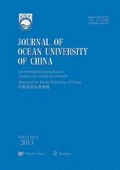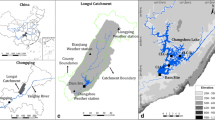Abstract
Through the geochemical analysis of two hundred-meters cores KD4 and ZK3 from Laizhou Bay, in this study, we determined the distribution law and controlling factors of the geochemical elements. We analyzed 24 elements with respect to their R factors and major principal components, which were combined with the source discrimination functions DFCr/Th and DFCa/Al to obtain the sediment source index and its variation with depth for this area. A comparison of the changes in climate indicators suggests a clear correlation between the source and climate changes. The results show that the Yellow River and surrounding short-term rivers are the main sediment sources in this area. The PC3 of the KD4 core and PC2 of the ZK3 core (e.g., CaO, MnO, SiO2) exhibit significant variations and reflect the relative contributions of Yellow River sources. The deposition process can be divided into six stages: in Phase I (MIS 5c-MIS 5a), the Yellow River formed, and the composition of the Yellow River had a greater influence on the sedimentary composition of the study area. In Phase II (MIS 5a-MIS 3), the sediment sources of the Yellow River and the short-term streams in this area were wavering, with the sediments derived from short-term rivers playing a more important role. In Phase III (MIS 3), with a sharp drop in temperature, the study area was in the process of retreat, and the sediment source changed from the Yellow River to short-term rivers, after which the Yellow River source material remained the main sediment source for the region. A similar process occurred three more times in Phase IV (MIS 3-MIS 2), Phase V (MIS 2-MIS 1), and Phase VI (MIS 1). With changes in climate, especially during alternating sea-land phases, the sediment source varied in marine-terrestrial-marine phases, and the changes are observed as Yellow River source-surrounding provenance-Yellow River source. However, this process of change is not synchronized with the sea-land strata alternation.
Similar content being viewed by others
References
Armstrong-Altrin, J. S., Machain-Castillo, M. L., Rosales-Hoz, L., Carranza-Edwards, A., Sanchez-Cabeza, J., and Ruíz-Fernández, A. C., 2015. Provenance and depositional history of continental slope sediments in the southwestern Gulf of Mexico unraveled by geochemical analysis. Continental Shelf Research, 95: 15–26.
Cho, Y. G., Lee, C. B., and Choi, M. S., 1999. Geochemistry of surface sediments off the southern and western coasts of Korea. Marine Geology, 159 (1-4): 111–129.
Davis, J. C., and Sampson, R. J., 1986. Statistical and Data Analysis in Geology. Wiley, New York, 316–333.
Fralick, P. W., and Kronberg, B. I., 1997. Geochemical discrimination of clastic sedimentary rock sources. Sedimentary Geology, 113 (1-2): 111–124.
Gong, C. Z., Liu, Y., Dai, Y. C., Xing, L., Wang, X. D., and Li, G. X., 2014. Geochemical features of the modern Yellow River mouth since late Pleistocene. Marine Geology Frontiers, 30 (11): 22–31 (in Chinese with English abstract).
Gu, Z. Y., Han, J. M., and Liu, D. S., 2000. Progress in geo-chemical research on the loess and other Quaternary deposits in China. Quaternary Sciences, 1: 41–55.
Hao, Q. Z., Guo, Z. T., Qiao, Y. S., Xu, B., and Oldfield, F., 2010. Geochemical evidence for the provenance of middle Pleistocene loess deposits in southern China. Quaternary Science Reviews, 29 (23): 3317–3326.
Jiang, F. Q., Zhou, X. J., Li, A. C., and Li, T. G., 2009. Quantitatively distinguishing sediments from the Yangtze River and the Yellow River using δEuN-ΣREEs plot. Science in China Series D: Earth Sciences, 52 (2): 232–241.
Kim, G., Yang, H. S., and Kodama, Y., 1998. Distributions of transition elements in the surface sediments of the Yellow Sea. Continental Shelf Research, 18 (12): 1531–1542.
Kremling, K., and Streu, P., 1993. Saharan dust influenced trace element fluxes in deep North Atlantic subtropical waters. Deep Sea Research Part I: Oceanographic Research Papers, 40 (6): 1155–1168.
Lan, X. H., Wang, H. X., Li, R. H., Lin, Z. H., and Zhang, Z. X., 2007. Major elements composition and provenance analysis in the sediments of the South Yellow Sea. Earth Science Frontiers, 14 (4): 197–203.
Lan, X. H., Zhang, X. J., Wang, H. X., Zhao, G. T., Zhang, Z. X., and Lin, Z. H., 2008. Sedimentary geochemistry in core NT2 of the South Yellow Sea and its provenance. Marine Geology and Quaternary Geology, 28 (1): 51–60 (in Chinese with English abstract).
Lee, C. B., Jung, H. S., and Jeong, K. S., 1992. Distribution of some metallic elements in surface sediments of the southeastern Yellow Sea. Journal of the Oceanological Society of Korea, 27: 55–65.
Lü, X. X., Versteegh, G. J. M., Song, J. M., Li, X. G., Yuan, H. M., and Li, N., 2016. Geochemistry of middle Holocene sediments from south Yellow Sea: Implications to provenance and climate change. Journal of Earth Science, 27 (5): 751–762.
McLennan, S. M., Hemming, S., McDaniel, D. K., and Hanson, G. N., 1993. Geochemical approaches to sedimentation, provenance, and tectonics. In: Processes Controlling the Composition of Clastic Sediments. Johnsson, M. J., and Basu, J., eds., the Geological Society of America, Boulder, 1–21.
Perri, F., Critelli, S., Mongelli, G., and Cullers, R. L., 2011. Sedimentary evolution of the Mesozoic continental redbeds using geochemical and mineralogical tools: The case of upper Triassic to lowermost Jurassic Monte di Gioiosa mudrocks (Sicily, southern Italy). International Journal of Earth Sciences, 100 (7): 1569–1587.
Singh, A., Paul, D., Sinha, R., Thomsen, K. J., and Gupta, S., 2016. Geochemistry of buried river sediments from Ghaggar Plains, NW India: Multi-proxy records of variations in provenance, paleoclimate, and paleovegetation patterns in the late Quaternary. Palaeogeography, Palaeoclimatology, Palaeoecology, 449: 85–100.
Song, S., Feng, X. L., Li, G. G., Liu, X., Xiao, X., and Li, F., 2018. Change in sediment provenance near the current estuary of Yellow River since the Holocene transgression. Journal of Ocean University of China, 17 (3): 535–544.
Sun, D. Y., Tan, W. B., Pei, Y. D., Zhou, L. P., Wang, H., Yang, H., and Xu, Y. P., 2011. Late Quaternary environmental change of Yellow River Basin: An organic geochemical record in Bohai Sea (North China). Organic Geochemistry, 42 (6): 575–585.
Usunoff, E. J., and Guzmán-Guzmán, A., 1989. Multivariate analysis in hydrochemistry: An example of the use of factor and correspondence analyses. Ground Water, 27 (1): 27–34.
Wang, F., Li, J., Chen, Y., Fang, J., Zong, Y., Shang, Z., and Wang, H., 2015. The record of mid-Holocene maximum land-ward marine transgression in the west coast of Bohai Bay, China. Marine Geology, 359: 89–95.
Xu, Q. M., Yang, J. L., Yuan, G. B., Chu, Z. X., and Zhang, Z. K., 2015. Stratigraphic sequence and episodes of the ancient Huanghe Delta along the southwestern Bohai Bay since the LGM. Marine Geology, 367: 69–82.
Xu, Z. K., Li, T. G., Nan, Q. Y., Yu, X. K., Li, A. C., and Choi, J. Y., 2012. Paleoenvironmental changes in the northern Okinawa trough since 25 ka BP: REE and organic carbon evidence. Journal of Earth Science, 23 (3): 297–310.
Xue, C. T., Zhou, Y. Q., and Zhu, X. H., 2004. The Huanghe River course and delta from end of late Pleistocene to the 7th century BC. Acta Oceanologica Sinica, 26 (1): 48–61.
Yang, S. Y., and Li, C. X., 2000. Elemental composition in the sediments of the Yangtze and the Yellow Rivers and their tracing implication. Progress in Natural Science, 10 (8): 54–60.
Yang, S. Y., and Youn, J. S., 2007. Geochemical compositions and provenance discrimination of the central South Yellow Sea sediments. Marine Geology, 243 (1-4): 229–241.
Yang, S. Y., Cai, J. G., Li, C. X., and Deng, B., 2001. New discussion about the run-through time of the Yellow River. Marine Geology and Quaternary Geology, 21 (2): 17–22 (in Chinese with English abstract).
Yang, S. Y., Jung, H. S., Li, C. X., and Lim, D. I., 2004. Major element geochemistry of sediments from Chinese and Korean Rivers. Geochemic, 33 (1): 99–105 (in Chinese with English abstract).
Yang, S. Y., Li, C. X., Jung, H. S., and Lee, H. J., 2002. Discrimination of geochemical compositions between the Chang-jiang and the Huanghe sediments and its application for the identication of sediment source in the Jiangsu coastal plain, China. Marine Geology, 186: 229–241.
Yang, S. Y., Li, C. X., Lee, C. B., and Na, T. K., 2003. REE geochemistry of suspended sediments from the rivers around the Yellow Sea and provenance indicators. Chinese Science Bulletin, 48 (11): 1135–1139.
Yue, J., Dong, Y., Zhang, B. H., Mou, L., Wang, G. M., Chen, A. S., Yuan, B. Y., Liu, J. L., and Wei, J. H., 2011. Several geochemical indicators of the west coast of Bohai Sea. Acta Geologica Sinica, 85 (7): 1239–1250 (in Chinese with English abstract).
Acknowledgements
This work was supported by the China Geological Survey Project (Nos. GZH201100202 and DD20160158) and the Taishan Scholar Project.
Author information
Authors and Affiliations
Corresponding author
Rights and permissions
About this article
Cite this article
Gong, C., Li, G., Liu, Y. et al. Source Evolution and Its Relationship to Climate Change Since the Middle-Late Pleistocene in Laizhou Bay, China. J. Ocean Univ. China 19, 113–123 (2020). https://doi.org/10.1007/s11802-020-3937-z
Received:
Revised:
Accepted:
Published:
Issue Date:
DOI: https://doi.org/10.1007/s11802-020-3937-z



